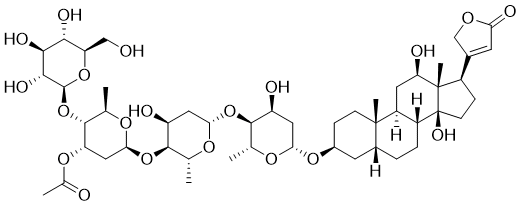Physicochemical Properties
| Molecular Formula | C49H76O20 |
| Molecular Weight | 985.1158 |
| Exact Mass | 984.493 |
| CAS # | 17575-22-3 |
| PubChem CID | 656630 |
| Appearance | White to off-white solid powder |
| Density | 1.42g/cm3 |
| Melting Point | 272-274°C |
| Index of Refraction | 1.608 |
| LogP | 0.613 |
| Hydrogen Bond Donor Count | 8 |
| Hydrogen Bond Acceptor Count | 20 |
| Rotatable Bond Count | 12 |
| Heavy Atom Count | 69 |
| Complexity | 1870 |
| Defined Atom Stereocenter Count | 26 |
| SMILES | C[C@@H]1[C@H]([C@H](C[C@@H](O1)O[C@H]2CC[C@]3([C@@H](C2)CC[C@@H]4[C@@H]3C[C@H]([C@]5([C@@]4(CC[C@@H]5C6=CC(=O)OC6)O)C)O)C)O)O[C@H]7C[C@@H]([C@@H]([C@H](O7)C)O[C@H]8C[C@@H]([C@@H]([C@H](O8)C)O[C@H]9[C@@H]([C@H]([C@@H]([C@H](O9)CO)O)O)O)OC(=O)C)O |
| InChi Key | JAYAGJDXJIDEKI-PTGWOZRBSA-N |
| InChi Code | InChI=1S/C49H76O20/c1-21-43(67-38-17-32(53)44(22(2)62-38)68-39-18-33(64-24(4)51)45(23(3)63-39)69-46-42(58)41(57)40(56)34(19-50)66-46)31(52)16-37(61-21)65-27-9-11-47(5)26(14-27)7-8-29-30(47)15-35(54)48(6)28(10-12-49(29,48)59)25-13-36(55)60-20-25/h13,21-23,26-35,37-46,50,52-54,56-59H,7-12,14-20H2,1-6H3/t21-,22-,23-,26-,27+,28-,29-,30+,31+,32+,33+,34-,35-,37+,38+,39+,40-,41+,42-,43-,44-,45-,46+,47+,48+,49+/m1/s1 |
| Chemical Name | [(2R,3R,4S,6S)-6-[(2R,3S,4S,6S)-6-[(2R,3S,4S,6R)-6-[[(3S,5R,8R,9S,10S,12R,13S,14S,17R)-12,14-dihydroxy-10,13-dimethyl-17-(5-oxo-2H-furan-3-yl)-1,2,3,4,5,6,7,8,9,11,12,15,16,17-tetradecahydrocyclopenta[a]phenanthren-3-yl]oxy]-4-hydroxy-2-methyloxan-3-yl]oxy-4-hydroxy-2-methyloxan-3-yl]oxy-2-methyl-3-[(2S,3R,4S,5S,6R)-3,4,5-trihydroxy-6-(hydroxymethyl)oxan-2-yl]oxyoxan-4-yl] acetate |
| HS Tariff Code | 2934.99.9001 |
| Storage |
Powder-20°C 3 years 4°C 2 years In solvent -80°C 6 months -20°C 1 month |
| Shipping Condition | Room temperature (This product is stable at ambient temperature for a few days during ordinary shipping and time spent in Customs) |
Biological Activity
| ln Vitro | Dengue virus RNA and viral protein production dosage decreases were also noted following treatment with increasing lanocin C doses. Trichoside C inhibits the early stages of the dengue virus replication cycle, according to time-of-addition studies. Cinnamin C also works against human destructive virus 71, flavivirus Kunjin, alphaviruses chikungunya and Sindbis, and all four serotypes of the dengue virus. Broad-spectrum antiviral activity of lanatoside C is demonstrated against multiple types of forward-sense RNA viruses [2]. |
| References |
[1]. Intracranial AAV-sTRAIL combined with lanatoside C prolongs survival in an orthotopic xenograft mouse model of invasive glioblastoma. Mol Oncol. 2015 Dec 11. pii: S1574-7891(15)00226-4. [2]. Antiviral activity of lanatoside C against dengue virus infection. Antiviral Res. 2014 Nov;111:93-99. |
| Additional Infomation | lanatoside C has been reported in Digitalis lamarckii, Digitalis grandiflora, and other organisms with data available. |
Solubility Data
| Solubility (In Vitro) |
DMSO : ~50 mg/mL (~50.76 mM) Ethanol : ~2 mg/mL (~2.03 mM) |
| Solubility (In Vivo) |
Solubility in Formulation 1: ≥ 2.08 mg/mL (2.11 mM) (saturation unknown) in 10% DMSO + 40% PEG300 + 5% Tween80 + 45% Saline (add these co-solvents sequentially from left to right, and one by one), clear solution. For example, if 1 mL of working solution is to be prepared, you can add 100 μL of 20.8 mg/mL clear DMSO stock solution to 400 μL PEG300 and mix evenly; then add 50 μL Tween-80 to the above solution and mix evenly; then add 450 μL normal saline to adjust the volume to 1 mL. Preparation of saline: Dissolve 0.9 g of sodium chloride in 100 mL ddH₂ O to obtain a clear solution. Solubility in Formulation 2: ≥ 2.08 mg/mL (2.11 mM) (saturation unknown) in 10% DMSO + 90% (20% SBE-β-CD in Saline) (add these co-solvents sequentially from left to right, and one by one), clear solution. For example, if 1 mL of working solution is to be prepared, you can add 100 μL of 20.8 mg/mL clear DMSO stock solution to 900 μL of 20% SBE-β-CD physiological saline solution and mix evenly. Preparation of 20% SBE-β-CD in Saline (4°C,1 week): Dissolve 2 g SBE-β-CD in 10 mL saline to obtain a clear solution. Solubility in Formulation 3: ≥ 2.08 mg/mL (2.11 mM) (saturation unknown) in 10% DMSO + 90% Corn Oil (add these co-solvents sequentially from left to right, and one by one), clear solution. For example, if 1 mL of working solution is to be prepared, you can add 100 μL of 20.8 mg/mL clear DMSO stock solution to 900 μL of corn oil and mix evenly. Solubility in Formulation 4: ≥ 0.2 mg/mL (0.20 mM) (saturation unknown) in 10% EtOH + 40% PEG300 + 5% Tween80 + 45% Saline (add these co-solvents sequentially from left to right, and one by one), clear solution. For example, if 1 mL of working solution is to be prepared, you can add 100 μL of 2.0 mg/mL clear EtOH stock solution to 400 μL of PEG300 and mix evenly; then add 50 μL of Tween-80 to the above solution and mix evenly; then add 450 μL of normal saline to adjust the volume to 1 mL. Preparation of saline: Dissolve 0.9 g of sodium chloride in 100 mL ddH₂ O to obtain a clear solution. Solubility in Formulation 5: ≥ 0.2 mg/mL (0.20 mM) (saturation unknown) in 10% EtOH + 90% (20% SBE-β-CD in Saline) (add these co-solvents sequentially from left to right, and one by one), clear solution. For example, if 1 mL of working solution is to be prepared, you can add 100 μL of 2.0 mg/mL clear EtOH stock solution to 900 μL of 20% SBE-β-CD physiological saline solution and mix evenly. Preparation of 20% SBE-β-CD in Saline (4°C,1 week): Dissolve 2 g SBE-β-CD in 10 mL saline to obtain a clear solution. Solubility in Formulation 6: ≥ 0.2 mg/mL (0.20 mM) (saturation unknown) in 10% EtOH + 90% Corn Oil (add these co-solvents sequentially from left to right, and one by one), clear solution. For example, if 1 mL of working solution is to be prepared, you can add 100 μL of 2.0 mg/mL clear EtOH stock solution to 900 μL of corn oil and mix well. (Please use freshly prepared in vivo formulations for optimal results.) |
| Preparing Stock Solutions | 1 mg | 5 mg | 10 mg | |
| 1 mM | 1.0151 mL | 5.0755 mL | 10.1510 mL | |
| 5 mM | 0.2030 mL | 1.0151 mL | 2.0302 mL | |
| 10 mM | 0.1015 mL | 0.5076 mL | 1.0151 mL |
